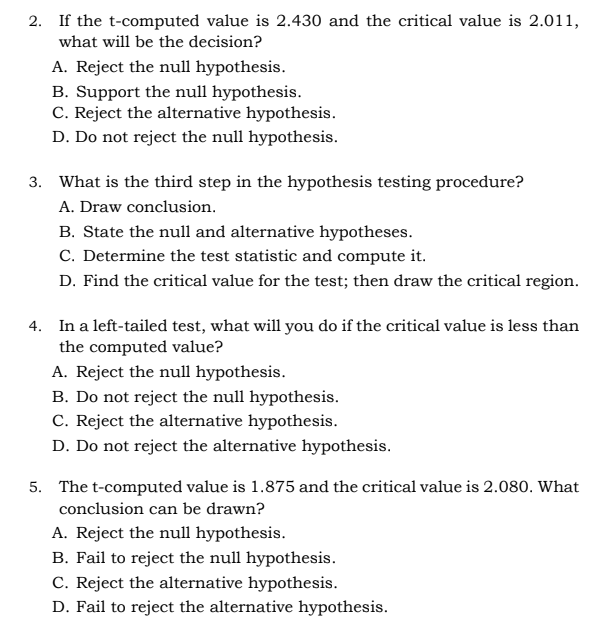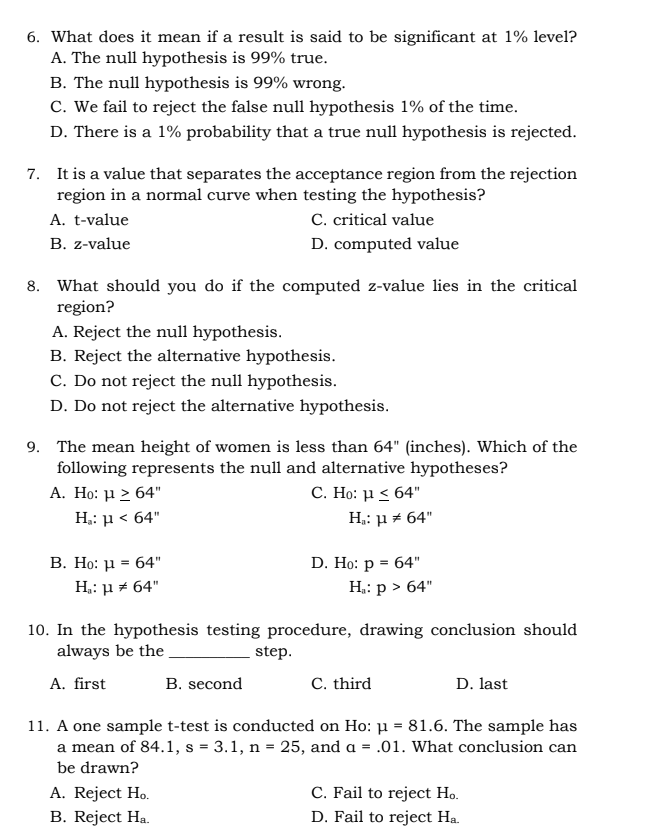2. If the t-computed value is 2.430 and the critical value is 2.011, what will be the decision? A. Reject the null hypothesis. B. Support the null hypothesis. C. Reject the alternative hypothesis. D. Do not reject the null hypothesis.
2. If the t-computed value is 2.430 and the critical value is 2.011, what will be the decision? A. Reject the null hypothesis. B. Support the null hypothesis. C. Reject the alternative hypothesis. D. Do not reject the null hypothesis.
A First Course in Probability (10th Edition)
10th Edition
ISBN:9780134753119
Author:Sheldon Ross
Publisher:Sheldon Ross
Chapter1: Combinatorial Analysis
Section: Chapter Questions
Problem 1.1P: a. How many different 7-place license plates are possible if the first 2 places are for letters and...
Related questions
Topic Video
Question
Answer the following questions withn correct answers

Transcribed Image Text:2. If the t-computed value is 2.430 and the critical value is 2.011,
what will be the decision?
A. Reject the null hypothesis.
B. Support the null hypothesis.
C. Reject the alternative hypothesis.
D. Do not reject the null hypothesis.
3. What is the third step in the hypothesis testing procedure?
A. Draw conclusion.
B. State the null and alternative hypotheses.
C. Determine the test statistic and compute it.
D. Find the critical value for the test; then draw the critical region.
4. In a left-tailed test, what will you do if the critical value is less than
the computed value?
A. Reject the null hypothesis.
B. Do not reject the null hypothesis.
C. Reject the alternative hypothesis.
D. Do not reject the alternative hypothesis.
5. The t-computed value is 1.875 and the critical value is 2.080. What
conclusion can be drawn?
A. Reject the null hypothesis.
B. Fail to reject the null hypothesis.
C. Reject the alternative hypothesis.
D. Fail to reject the alternative hypothesis.

Transcribed Image Text:6. What does it mean if a result is said to be significant at 1% level?
A. The null hypothesis is 99% true.
B. The null hypothesis is 99% wrong.
C. We fail to reject the false null hypothesis 1% of the time.
D. There is a 1% probability that a true null hypothesis is rejected.
7. It is a value that separates the acceptance region from the rejection
region in a normal curve when testing the hypothesis?
A. t-value
C. critical value
B. z-value
D. computed value
8. What should you do if the computed z-value lies in the critical
region?
A. Reject the null hypothesis.
B. Reject the alternative hypothesis.
C. Do not reject the null hypothesis.
D. Do not reject the alternative hypothesis.
9. The mean height of women is less than 64" (inches). Which of the
following represents the null and alternative hypotheses?
A. Ho: μ 2 64"
C. Ho: μ< 64"
H: µ < 64"
H: µ + 64"
D. Ho: р %3D 64"
В. Но: и 3 64"
H.: µ + 64"
H,: p > 64"
10. In the hypothesis testing procedure, drawing conclusion should
always be the
step.
A. first
B. second
C. third
D. last
11. A one sample t-test is conducted on Ho: µ = 81.6. The sample has
a mean of 84.1, s = 3.1, n = 25, and a = .01. What conclusion can
be drawn?
A. Reject Ho.
B. Reject Ha.
C. Fail to reject Ho.
D. Fail to reject Ha.
Expert Solution
This question has been solved!
Explore an expertly crafted, step-by-step solution for a thorough understanding of key concepts.
This is a popular solution!
Trending now
This is a popular solution!
Step by step
Solved in 2 steps

Knowledge Booster
Learn more about
Need a deep-dive on the concept behind this application? Look no further. Learn more about this topic, probability and related others by exploring similar questions and additional content below.Recommended textbooks for you

A First Course in Probability (10th Edition)
Probability
ISBN:
9780134753119
Author:
Sheldon Ross
Publisher:
PEARSON


A First Course in Probability (10th Edition)
Probability
ISBN:
9780134753119
Author:
Sheldon Ross
Publisher:
PEARSON
